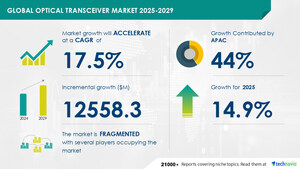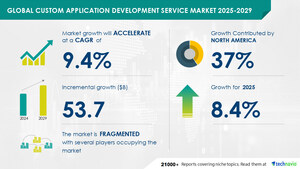NEW YORK, July 18, 2022 /PRNewswire/ -- The Footwear Market is segmented by Geography (APAC, North America, Europe, South America, and MEA). 38% of the market's growth will originate from APAC during the forecast period. China and India are the key markets for footwear in APAC. Market growth in this region will be faster than the growth of the market in other regions. The rising disposable incomes of people, the increasing preference for premium footwear, and the growing health consciousness among people will facilitate the footwear market growth in APAC over the forecast period. Moreover, the Footwear Market Share is expected to increase by USD 16.85 billion from 2020 to 2025, with an accelerated CAGR of 1.13%- according to the recent market study by Technavio. The report provides a detailed analysis of drivers & opportunities, top winning strategies, competitive scenario, future market trends, market size & estimations, and major investment pockets.
Visualize Footwear Market using Technavio Intelligence. Browse Summary of the Research Report to Learn More
Vendor Insights-
The footwear market report also offers information on several market vendors, including adidas AG, ASICS Corp., Burberry Group Plc, New Balance Athletics Inc., Nike Inc., PUMA SE, Skechers USA Inc., Under Armour Inc., VF Corp., and Wolverine World Wide Inc. among others. The footwear market is fragmented and the vendors are deploying organic and inorganic growth strategies to compete in the market. Moreover, to make the most of the opportunities and recover from post COVID-19 impact, market vendors should focus more on the growth prospects in the fast-growing segments, while maintaining their positions in the slow-growing segments.
- adidas AG - The company offers a wide range of footwear under the brands of Reebok and Adidas.
- Burberry Group Plc - The company offers a wide range of footwear such as sandals, formal shoes, boots, sneakers, and others.
- New Balance Athletics Inc. - The company offers a wide range of footwear such as lifestyle shoes, baseball shoes, hiking and trail shoes, work shoes, sandals, soccer shoes, boots, and others.
Get More Information on Macro & Micro Economic Factor Analysis, Statistical Tools, and Trend Projection. Request Sample Copy (Including Graphs & Tables) of this Report
Segmentation Analysis & Forecasts
The footwear market is segmented by Product (non-athletic footwear and athletic footwear), End-user (women, men, and children), and Distribution channel (offline and online). The footwear market share growth in the nonathletic footwear segment will be significant during the forecast period. The key factors driving the demand for non-athletic footwear include the growing consumer fashion consciousness and the rising introduction of trendy shoes in the men and children segments. In addition, the demand for private-label brands is increasing due to the availability of top-quality product offerings at low prices. The growth in the demand for premium non-athletic footwear is mainly attributed to the rising disposable income of the population across the globe. High disposable incomes of consumers raise their spending power, empowering them to spend more on premium fashion products such as footwear.
Download Sample Report Using Business Email ID to Gain Further Insights on the Market Contribution of Various Segments on Higher Priority
Latest Drivers & Challenges of the Market-
- Footwear Market Driver:
- Design and material innovations leading to product premiumization:
The vendors are constantly innovating and introducing new patterns and designs due to market competition and evolving customer demand because of continuous changes in the fashion industry. Customers seek footwear for formal, especially leather footwear, and casual, such as sports or canvas shoes, purposes. Therefore, the vendors regularly expand their brand and product lines. Athletic footwear belongs to the promoted product segment. The demand for such footwear has been increasing because of the availability of innovative products, which offer premium appeal, that can also be used as partywear. High demand and premiumization allow manufacturers to increase the price of their products. Innovations in designs and celebrity endorsements of products have enabled vendors to cater to the demand from the high-income customer base. Key vendors design personalized and customized athletic shoes to expand their customer base.
- Footwear Market Challenge:
- Rising labor cost and fluctuating raw material prices:
Several international vendors, such as Prada,Tapestry, and D&G, have their own production facilities or original equipment manufacturers (OEMs) in Asian countries, such as China, India, Indonesia, Bangladesh, and Vietnam. This is due to the availability of low-cost manufacturing and the low cost of operations in these countries. However, in the last decade, the cost of labor in these countries rose rapidly, which increased the cost of production. Evolving and dynamic economic conditions have also adversely affected the cost of labor in countries from which the vendors import their supplies. Therefore, the rising cost of production for the manufacturers lowers their profit margins. Fluctuations in raw material costs are another challenge for vendors. The cost of these materials is also dependent on transportation costs. The transportation costs incurred by companies include taxes, duties, and fuel costs. A major portion of the transportation cost incurred by the vendors is the cost of fuel, which fluctuates frequently. An increase in transportation costs increases the cost of end products.
For More Insights on the Latest Drivers, Trends, and Challenges that will Help Companies Evaluate and Develop Growth Strategies. Read Sample Report
Didn't Find What You Were Looking For Customize Report-
Don't miss out on the opportunity to speak to our analyst and know more insights about this market report. Our analysts can also help you customize this report according to your needs. Our analysts and industry experts will work directly with you to understand your requirements and provide you with customized data in a short amount of time.
Speak to our Analyst now! to take full advantage of every opportunity using competitive analysis created just for you
Here are Some Similar Topics-
- Tactical Footwear Market by End-user and Geography - Forecast and Analysis 2022-2026: The tactical footwear market share is expected to increase to USD 526.77 million from 2021 to 2026, and the market's growth momentum will accelerate at a CAGR of 5.57%. 45% of the market's growth will originate from APAC during the forecast period. China and India are the key markets for the tactical footwear market in APAC. Market growth in this region will be faster than the growth of the market in other regions. Find More Research Insights Here
- Online Footwear Market Growth, Size, Trends, Analysis Report by Type, Application, Region and Segment Forecast 2021-2025: The online footwear market share is expected to increase by USD 21.48 billion from 2020 to 2025, and the market's growth momentum will accelerate at a CAGR of 5.29%. The online footwear market is fragmented, and the vendors are deploying growth strategies such as transport and logistics disruptions to compete in the market. To make the most of the opportunities and recover from post COVID-19 impact, market vendors should focus more on the growth prospects in the fast-growing segments, while maintaining their positions in the slow-growing segments. Find More Research Insights Here
Footwear Market Scope |
|
Report Coverage |
Details |
Page number |
120 |
Base year |
2020 |
Forecast period |
2021-2025 |
Growth momentum & CAGR |
Accelerate at a CAGR of 1.13% |
Market growth 2021-2025 |
$ 16.85 billion |
Market structure |
Fragmented |
YoY growth (%) |
-0.72 |
Regional analysis |
APAC, MEA, North America, South America, and Europe |
Performing market contribution |
APAC at 38% |
Key consumer countries |
US, China, Germany, and France |
Competitive landscape |
Leading companies, competitive strategies, consumer engagement scope |
Companies profiled |
adidas AG, ASICS Corp., Burberry Group PLC, New Balance Athletics Inc., Nike Inc., PUMA SE, Skechers USA Inc., Under Armour Inc., VF Corp., and Wolverine World Wide Inc. |
Market Dynamics |
Parent market analysis, Market growth inducers and obstacles, Fast-growing and slow-growing segment analysis, COVID 19 impact and future consumer dynamics, market condition analysis for forecast period, |
Customization preview |
If our report has not included the data that you are looking for, you can reach out to our analysts and get segments customized. |
Table of Contents
1. Executive Summary
2. Market Landscape
2.1 Market ecosystem
Exhibit 01: Parent market
2.2 Market Characteristics
Exhibit 02: Market Characteristics
2.3 Value chain analysis
Exhibit 03: Value Chain Analysis: Apparel, accessories, luxury goods, footwear, and textiles
2.3.1 Inputs
2.3.2 Inbound logistics
2.3.3 Operations
2.3.4 Outbound logistics
2.3.5 Marketing and sales
2.3.6 Service
Support activities
Innovations
3. Market Sizing
3.1 Market definition
Exhibit 04: Offerings of vendors included in the market definition
3.2 Market segment analysis
Exhibit 05: Market segments
3.3 Market size 2020
3.4 Market outlook: Forecast for 2020 - 2025
Exhibit 06: Global - Market size and forecast 2020 - 2025 ($ billion)
Exhibit 07: Global market: Year-over-year growth 2020 - 2025 (%)
4. Five Forces Analysis
4.1 Five Forces Summary
Exhibit 08: Five forces analysis 2020 & 2025
4.2 Bargaining power of buyers
Exhibit 09: Bargaining power of buyers
4.3 Bargaining power of suppliers
Exhibit 10: Bargaining power of suppliers
4.4 Threat of new entrants
Exhibit 11: Threat of new entrants
4.5 Threat of substitutes
Exhibit 12: Threat of substitutes
4.6 Threat of rivalry
Exhibit 13: Threat of rivalry
4.7 Market condition
Exhibit 14: Market condition - Five forces 2020
5. Market Segmentation by Product
The segments covered in this chapter are:
- Non athletic footwear
- Athletic footwear
Non athletic footwear has the highest growth while athletic footwear has the lowest growth
5.1 Market segments
Exhibit 15: Product- Market share 2020-2025 (%)
5.2 Comparison by Product
Exhibit 16: Comparison by Product
5.3 Non athletic footwear - Market size and forecast 2020-2025
Exhibit 17: Non athletic footwear - Market size and forecast 2020-2025 ($ billion)
Exhibit 18: Non athletic footwear - Year-over-year growth 2020-2025 (%)
5.4 Athletic footwear - Market size and forecast 2020-2025
Exhibit 19: Athletic footwear - Market size and forecast 2020-2025 ($ billion)
Exhibit 20: Athletic footwear - Year-over-year growth 2020-2025 (%)
5.5 Market opportunity by Type
6. Market Segmentation by End-user
The segments covered in this chapter are:
- Women
- Men
- Children
Here women have the highest growth than men and children segments.
6.1 Market segments
Exhibit 22: End user - Market share 2020-2025 (%)
6.2 Comparison by End user
Exhibit 23: Comparison by End user
Exhibit 21: Market opportunity by Product
6.3 Women - Market size and forecast 2020-2025
Exhibit 24: Women - Market size and forecast 2020-2025 ($ billion)
Exhibit 25: Women - Year-over-year growth 2020-2025 (%)
6.4 Men - Market size and forecast 2020-2025
Exhibit 26: Men - Market size and forecast 2020-2025 ($ billion)
Exhibit 27: Men - Year-over-year growth 2020-2025 (%)
6.5 Children - Market size and forecast 2020-2025
Exhibit 28: Children - Market size and forecast 2020-2025 ($ billion)
Exhibit 29: Children - Year-over-year growth 2020-2025 (%)
6.6 Market opportunity by End user
Exhibit 30: Market opportunity by End user
7. Market Segmentation by Distribution channel
The segments covered in this chapter are:
- Offline
- Online
Here offline distribution has more growth than online distribution
7.1 Market segments
Exhibit 31: Distribution channel - Market share 2020-2025 (%)
7.2 Comparison by Distribution channel
Exhibit 32: Comparison by Distribution channel
7.3 Offline - Market size and forecast 2020-2025
Exhibit 33: Offline - Market size and forecast 2020-2025 ($ billion)
Exhibit 34: Offline - Year-over-year growth 2020-2025 (%)
7.4 Online - Market size and forecast 2020-2025
Exhibit 35: Online - Market size and forecast 2020-2025 ($ billion)
Exhibit 36: Online - Year-over-year growth 2020-2025 (%)
7.5 Market opportunity by Distribution channel
Exhibit 37: Market opportunity by Distribution channel
8. Customer landscape
Technavio's customer landscape matrix comparing Drivers or price sensitivity, Adoption lifecycle, importance in customer price basket, Adoption rate and Key purchase criteria
Exhibit 38: Customer landscape
9. Geographic Landscape
The regions covered in the report are:
- North America
- Europe
- APAC
- South America
- MEA
APAC was the largest region of the market in 2020
9.1 Geographic segmentation
Exhibit 39: Market share by geography 2020-2025 (%)
9.2 Geographic comparison
Exhibit 40: Geographic comparison
9.3 APAC - Market size and forecast 2020-2025
Exhibit 41: APAC - Market size and forecast 2020-2025 ($ billion)
Exhibit 42: APAC - Year-over-year growth 2020-2025 (%)
9.4 North America - Market size and forecast 2020-2025
Exhibit 43: North America - Market size and forecast 2020-2025 ($ billion)
Exhibit 44: North America - Year-over-year growth 2020-2025 (%)
9.5 Europe - Market size and forecast 2020-2025
Exhibit 45: Europe - Market size and forecast 2020-2025 ($ billion)
Exhibit 46: Europe - Year-over-year growth 2020-2025 (%)
9.6 South America - Market size and forecast 2020-2025
Exhibit 47: South America - Market size and forecast 2020-2025 ($ billion)
Exhibit 48: South America - Year-over-year growth 2020-2025 (%)
9.7 MEA - Market size and forecast 2020-2025
Exhibit 49: MEA - Market size and forecast 2020-2025 ($ billion)
Exhibit 50: MEA - Year-over-year growth 2020-2025 (%)
9.8 Key leading countries
Exhibit 51: Key leading countries
9.9 Market opportunity by geography
Exhibit 52: Market opportunity by geography ($ billion)
10. Drivers, Challenges, and Trends
10.1 Market drivers
10.1.1 Design and material innovations leading to product premiumization
10.1.2 Rising demand for exclusive designer collections
10.1.3 High influence of celebrity endorsements on customer purchase decisions
10.2 Market challenges
10.2.1 Rising labor cost and fluctuating raw material prices
10.2.2 Availability of counterfeit products
10.2.3 Stringent government regulations for procurement of raw materials such as leather
Exhibit 53: Impact of drivers and challenges
10.3 Market trends
10.3.1 Increasing demand for customized footwear
10.3.2 Rising demand for footwear made of organic leather
10.3.3 Emergence of smart shoes
11. Vendor Landscape
11.1 Vendor landscape
Exhibit 54: Vendor landscape
11.2 Landscape disruption
Exhibit 55: Landscape disruption
Exhibit 56: Industry risks
12. Vendor Analysis
12.1 Vendors covered
Exhibit 57: Vendors covered
12.2 Market positioning of vendors
Exhibit 58: Market positioning of vendors
12.3 adidas AG
Exhibit 59: adidas AG - Overview
Exhibit 60: adidas AG - Business segments
Exhibit 61: adidas AG – Key news
Exhibit 62: adidas AG - Key offerings
Exhibit 63: adidas AG - Segment focus
12.4 ASICS Corp.
Exhibit 64: ASICS Corp. - Overview
Exhibit 65: ASICS Corp. - Business segments
Exhibit 66: ASICS Corp. – Key news
Exhibit 67: ASICS Corp. - Key offerings
Exhibit 68: ASICS Corp. - Segment focus
12.5 Burberry Group Plc
Exhibit 69: Burberry Group Plc - Overview
Exhibit 70: Burberry Group Plc - Business segments
Exhibit 71: Burberry Group Plc – Key news
Exhibit 72: Burberry Group Plc - Key offerings
Exhibit 73: Burberry Group Plc - Segment focus
12.6 New Balance Athletics Inc.
Exhibit 74: New Balance Athletics Inc. - Overview
Exhibit 75: New Balance Athletics Inc. - Product and service
Exhibit 76: New Balance Athletics Inc. – Key news
Exhibit 77: New Balance Athletics Inc. - Key offerings
12.7 Nike Inc.
Exhibit 78: Nike Inc. - Overview
Exhibit 79: Nike Inc. - Business segments
Exhibit 80: Nike Inc. – Key news
Exhibit 81: Nike Inc. - Key offerings
Exhibit 82: Nike Inc. - Segment focus
12.8 PUMA SE
Exhibit 83: PUMA SE - Overview
Exhibit 85: PUMA SE– Key news
Exhibit 86: PUMA SE - Key offerings
Exhibit 87: PUMA SE - Segment focus
12.9 Skechers USA Inc.
Exhibit 88: Skechers USA Inc. - Overview
Exhibit 89: Skechers USA Inc. - Business segments
Exhibit 90: Skechers USA Inc. – Key news
Exhibit 91: Skechers USA Inc. - Key offerings
Exhibit 92: Skechers USA Inc. - Segment focus
12.10 Under Armour Inc.
Exhibit 93: Under Armour Inc. - Overview
Exhibit 94: Under Armour Inc. - Business segments
Exhibit 95: Under Armour Inc. – Key news
Exhibit 96: Under Armour Inc. - Key offerings
Exhibit 97: Under Armour Inc. - Segment focus
12.11 VF Corp.
Exhibit 98: VF Corp. - Overview
Exhibit 99: VF Corp. - Business segments
Exhibit 100: VF Corp.– Key news
Exhibit 101: VF Corp. - Key offerings
Exhibit 102: VF Corp. - Segment focus
12.12 Wolverine World Wide Inc.
Exhibit 103: Wolverine World Wide Inc. - Overview
Exhibit 104: Wolverine World Wide Inc. - Business segments
Exhibit 105: Wolverine World Wide Inc.– Key news
Exhibit 106: Wolverine World Wide Inc. - Key offerings
Exhibit 107: Wolverine World Wide Inc. - Segment focus
13. Appendix
13.1 Scope of the report
13.1.1 Market definition
13.1.2 Objectives
13.1.3 Notes and caveats
13.2 Currency conversion rates for US$
Exhibit 108: Currency conversion rates for US$
13.3 Research Methodology
Exhibit 109: Research Methodology
Exhibit 110: Validation techniques employed for market sizing
Exhibit 111: Information sources
13.4 List of abbreviations
Exhibit 112: List of abbreviations
Technavio is a leading global technology research and advisory company. Their research and analysis focus on emerging market trends and provides actionable insights to help businesses identify market opportunities and develop effective strategies to optimize their market positions. With over 500 specialized analysts, Technavio's report library consists of more than 17,000 reports and counting, covering 800 technologies, spanning across 50 countries. Their client base consists of enterprises of all sizes, including more than 100 Fortune 500 companies. This growing client base relies on Technavio's comprehensive coverage, extensive research, and actionable market insights to identify opportunities in existing and potential markets and assess their competitive positions within changing market scenarios.
Contact
Technavio Research
Jesse Maida
Media & Marketing Executive
US: +1 844 364 1100
UK: +44 203 893 3200
Email: [email protected]
Website: www.technavio.com/
SOURCE Technavio





Share this article